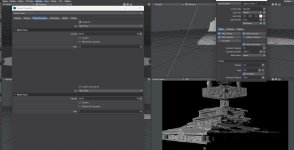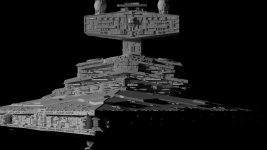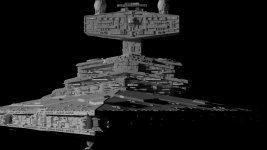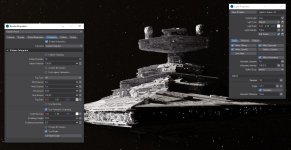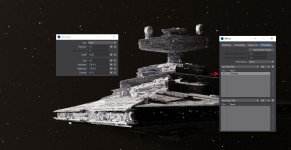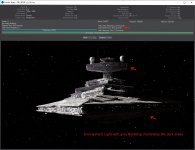I think at this stage if possible i need a bit more information on how this scene was set up, because whatever tried, i just cant seem to match it.
Environment light destroys the look of the shot and has no effect for the GI setting, seems like there is many different ways in each LW version which is annoying.
Wait, you do Not want the other side to have some slight illumination picked up from GI or environment lighting?
That kind of pitch dark isn´t the same as the rouge images I´ve seen, in fact they were much brighter than Thomas Leitners sample, which look more like the original Star Wars series. in some parts.
but that´s fixable by turning down environment lighting to very low levels if it´s too bright, and same with radiosity intensity.
You could also use a gradient directed so it comes in from the other side, but that may be overcourse right now.
Also, the surfaces, you need to adress those, I suspect you already have PBR materials and not standard, you could boost light reflected of the surface in some ways, turn off metallic, turn on glossy surfaces to avoid a flat dull look, but the roughness needs to be right.
Also, the actual light you are using, increase intensity on that instead.
You can add additional light insteads to fill in, or why not unseen geometry with high luminosity values nearby that area, or a half dome on that side, turn off seen by camera some other settings, can´t explain that all now though.
Unfortunately I can´t ask you to send a sample scene, because I am not toughing Lightwave 2020 ..rather wait till something new comes out.
As for each LW version changing so often, yep..more now than ever for Global Illumination and rendering, it´s such a rapid development everywhere on that..so Lightwave trying to keep up should be a good thing really, unless they made it worse, but in this case it seems you may not just understand how it works, and for anyone that intend to be serious and use it in production, I would give my opinion on that it should be required to read up on the new product, the new changes really..unless you like me are a hobby user that can sit here and complain about our lack of knowledge

Try check the surfaces first.
pbr, Right color, texture maps, right colors on those as well.
Increase light intensity.
Add additional lights.
Or Add luminous objects.
The scene you asked about, is of course a question for Thomas as you also adressed it to him, can´t help there.
).
